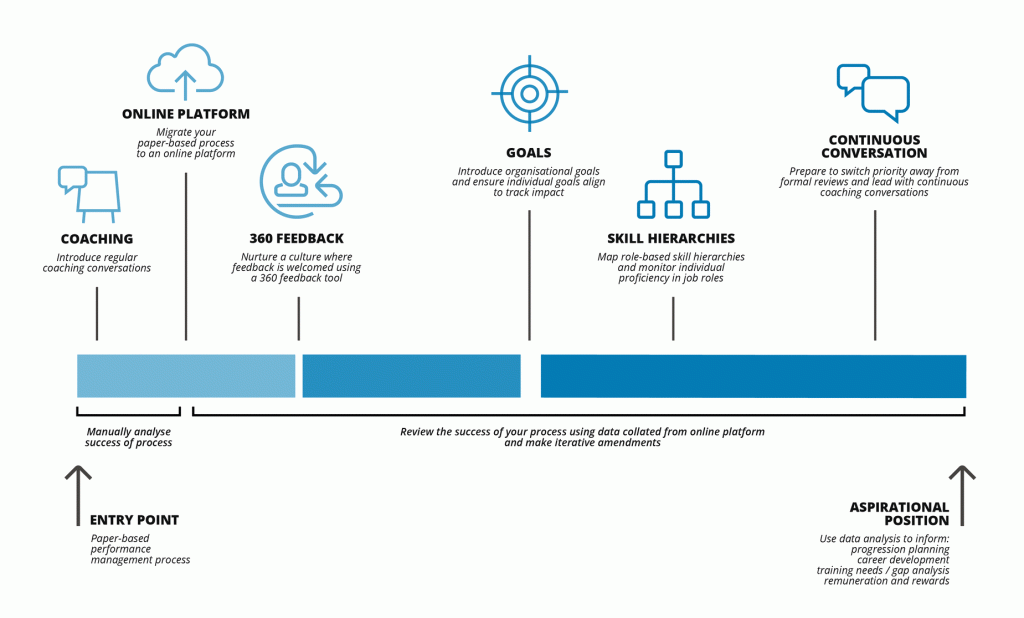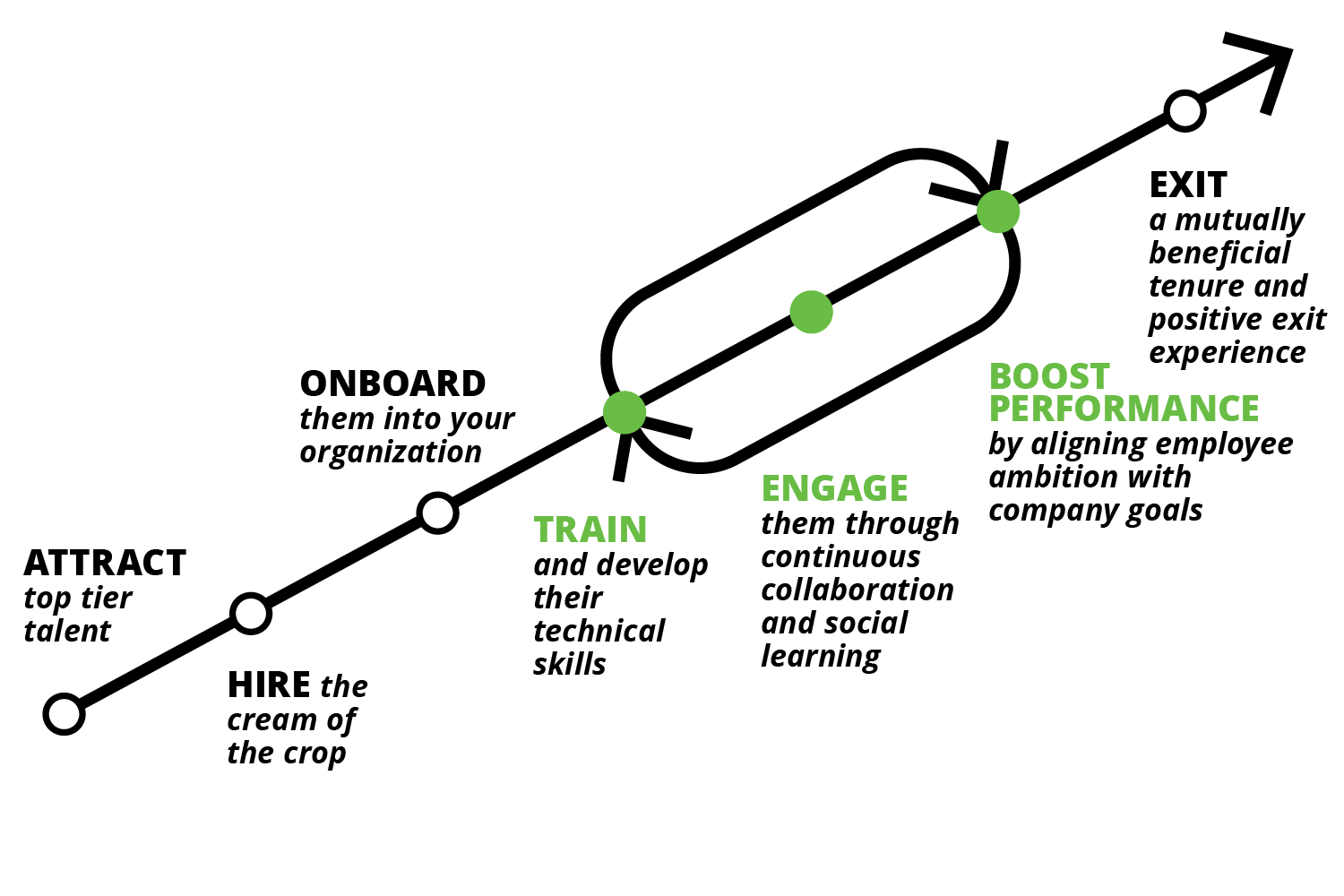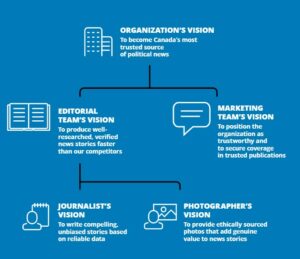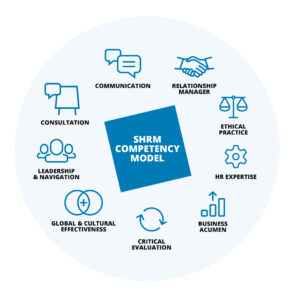Most talent management professionals agree that implementing continuous performance management is critical in today’s fast-moving world.
Left out of these affirming conversations, however, are specific steps elaborating how leaders in large organizations or agencies should transition from traditional performance management to a continuous process.
You’re probably already aware of the benefits and elements that constitute a continuous performance review process, such as:
-
Frequent feedback
-
Open communication
-
One-to-one check-ins
-
Objectives and key results
-
Adaptive talent management
But for HR and management leaders in large (or growing) organizations, safely shifting to continuous performance management presents unique challenges such as:
-
Picking the right continuous performance management software and tools
-
Operationalizing processes that empower managers and HR teams
-
Securing buy-in from decision-makers and employees
-
Setting realistic stakeholder and employee expectations
In this post, we’ve asked management, learning and HR experts to respond to these challenges with practical tips for implementing continuous performance management.
(Skip ahead to a specific subhead by clicking the links below)
- What is continuous performance management?
- Treat continuous performance management examples with caution
- Implementing continuous performance management: 6 practical tips
- Choosing continuous performance management software and tools for your organization
What is continuous performance management?

Continuous performance management (or continuous improvement performance management) is an agile approach to motivating employee performance, developing employees and aligning organizational objectives with employee goals.
Traditional performance management relies on an annual performance review process with long feedback loops between employees and managers.
Continuous performance management, on the other hand, embraces frequent measurement, objectives and key results (OKRs), continuous feedback and cumulative improvement throughout the year as opposed to annual or bi-annual appraisals and feedback cycles.
Treat continuous performance management templates with caution
There’s been plenty of coverage on continuous performance management in large enterprises:
-
In 2012, Donna Morris, Adobe’s then-Vice President of People Resources, announced plans to “ abolish the performance review ” format. This increased the company’s productivity significantly.
-
Inspired by Adobe’s success, Accenture, a tech giant with over 300,000 employees at the time, also dropped the annual review and numeric rating process to humanize performance management.
-
And today, companies like Apple, Google and Netflix—who are reported to be 40% more productive than the average organization—use continuous performance management strategies that focus on organizational structure and trust-building.
While there are some universal features of continuous performance management that work well in any large enterprise (better communication, frequent feedback cycles via 360-degree performance feedback, etc.) these successful examples (or any continuous performance management template) should be treated with caution.
This is because organizational survivor bias is real.
“Like so many company processes, when a company is doing “well” then the processes are exactly the right ones and magical. When a company is not doing so “well” then every process is either a symptom or the cause of the situation,” says Steven Sinofsky, Microsoft’s Ex-President for the Windows division, in a post about the challenges of performance management for large organizations.
Sinofsky urges leaders to account for their organization’s unique DNA by acknowledging the social science, corporate context and performance measurement issues that naturally surface when aiming to implement effective performance management reviews.
“It is not about the perfect review system but about the traps and pitfalls of just measuring stuff in general.”
Implementing continuous performance management: 6 practical tips

What are the top 6 practical tips for implementing a continuous performance management process in a large organization? Here’s what we found out when reviewing research and posing this question to talent and performance management leaders:
1. Build up to a continuous performance management process
“Gradually schedule the shift to continuous performance management on your calendar,” says Megan Bickle, Head of Performance Management, Succession and Talent Management at Dropbox.
To start, Megan advises that managers “take one of the 1:1’s in the month and use it to review progress against goals and provide clear performance feedback for teams.”
This is an effective way to make management-oriented changes “feel like less of a dramatic shift,” and as Megan highlights is a “practice any leader can implement on their own vs needing their organization to formally launch a more frequent cadence to manage performance.”
You can also use the following tips to implement continuous performance management in a risk-averse manner:
- Start slow. Speak to other decision-makers and key stakeholders holders involved. Compile the research (external and internal data) needed to make the case for influencing existing processes and employee performance management software
- Gather internal research and feedback from within your organization. Ask the question: what are the simplest changes you can test for the best possible ROI on performance? (Hint: The typical answer is frequent check-ins and the use of goals)
- Experiment with a single unit or department within your organization
Recommended read: Leading performance management in government: 4 modern strategies
2. Work backward from your organization’s outputs and ambitions
Guy W. Wallace , an enterprise performance analyst, suggests that “Good performance management requires an analysis of exactly what outputs are to be produced, by what behavioral and cognitive tasks. This understanding enables managers to provide feedback that reinforces positive performance or nudges lagging performance into an acceptable range.”
This advice echoes Totara’s philosophy of aligning talent experience by connecting learning, engagement and performance.
When a company and its employees align, motivation builds and everyone understands the part they play in the organization’s success. This leads to an adaptable organization that survives and thrives in the throes of turbulent marketplace change.

This is because working towards those all-important day-to-day goals—such as increasing sales, boosting productivity or achieving faster customer response times— is meaningless without the context of the organization’s wider vision.
For example, if an SEO manager understands that their personal work goal—to help the public find certain news stories—underpins their organization’s vision to become the country’s most-trusted source of political news, this context will help them better understand their role and provide a motivating vision to work towards.
3. Inspire employees with vision ambassadors
If you are going to inspire and motivate people across your organization (covering many roles, geographical locations, personalities and departments) with an effective continuous performance management process, you need to “market” your vision with precision.
Too vague, and the vision likely won’t mean anything to anyone. Equally, a vision that’s too specific might also fail to resonate across your entire workforce.

Entrepreneur William Craig suggests choosing a vision that is both compelling and practical by asking questions such as:
-
What is the organization’s primary purpose?
-
What are its core values?
-
What objective is to be accomplished over the longer term?
Once answered and conceptualized, these questions allow C-suite executives, management and HR staff to translate an abstract vision into something tangible and motivating for team members.
Another powerful way to do this is to use “vision ambassadors.”
Any marketing team will understand the benefits of brand ambassadors, but organizations can also reap the benefits of vision ambassadors—who keep the organization’s vision front of mind and emphasize its significance.
Vision ambassadors can range from senior management (the founder or CEO should play an important role here) to team managers and even trusted team members who embody and embrace the organization’s vision.
We trust our peers over lofty corporate statements, so enlisting the help of ambassadors at all levels helps you cultivate buy-in and enthusiasm.
4. Give employees and managers the tools for better feedback
“Educating your workforce on how to share meaningful feedback and manage goals/objectives is critical when transitioning from traditional performance management to continuous,” shares Harrison Kim, CEO of Pavestep.
“To succeed, you not only need the right tools and processes but also need to ensure that your team members are ready – both in their mindsets and skillsets. This is just as important as having leadership sponsorship.”
Giving and receiving feedback are important skills every good manager (and employee) needs within an organization that implements continuous performance management.
The delivery of feedback will depend on the situation—whether it’s positive or negative. There are, however, important steps to take that ensure negative feedback is approached in a professional (and productive) way for both management and staff:
Ask for permission to provide feedback
Particularly if you’re giving feedback in an informal check-in or in an ad hoc conversation, you should first ask the recipient if they mind you sharing feedback with them.
State what was observed
Be objective – don’t take sides or accuse them of anything. Instead, objectively state what you’ve observed or been told. If you are delivering feedback on behalf of someone else, be careful not to present it as a fact.
Explain the impact
Again, state the facts. Don’t bring emotion into it – simply tell the recipient of the feedback and what impact their behavior had on the organization or their peers, whether that’s creating more work for someone else, slowing down a process or upsetting a colleague.
Pause and listen
It’s crucial that you give the recipient of the feedback the chance to give their side of the story. It may be that you’re missing some important context, or that there’s a reasonable explanation for the behavior.
Suggest a positive next step
Feedback should be followed up with what action should be taken next. This may be a change in behavior, extra training, mentoring or something else. The recipient should come out of the conversation knowing what went wrong, what they can do to correct the situation and what you expect from them going forward.
5. Embrace next-gen competency frameworks
Career advancements are among the key ambitions driving employees to improve their skills and knowledge in the workplace.
For this reason, competency frameworks are an effective way for large organizations to track the major skills, abilities and attributes employees need to be successful in a job or organization.

“When implementing any performance management strategy, considering different employee needs and aspirations and connecting them to competencies, learning paths and virtual mentorships allows managers to remain adaptive towards any dynamic workforce and industry marketplace demands,” says Elena Gatti, a learning solutions consultant at Actua Solutions.
But most competency frameworks and mapping contain “fatal flaws” says Subbu Vinswathn , CEO of Disprz, an enterprise skills acceleration platform. The former McKinsey consultant warns that most competency frameworks are often “dated” or “too leadership-skills focused.”
“In today’s AI era in which new roles and competencies are constantly being created, it’s important for competency mapping to be kept up to date.”
To develop a well-rounded and relevant competency framework, Subbu advises that large companies focus on the four-step process below:
1. Knowledge areas that should be known from production worker to CEO: These are specific to your industry (e.g. retail manufacturing, healthcare or SaaS), your company history, values and regulations in your industry (such as, HIPAA compliance, IR35 or SF182).
2. Functional skills: These are the role-dependent hard skills required for each role. For example, the functional skills required from a learning and development admin include project management, course design and understanding LMS reporting/analytics .
3. Leadership skills: These are the soft skills required for different levels of leadership, irrespective of function.
4. Behaviors: For behaviors, Subbu notes that the “first three categories are measurable in some way, while behaviors are observable.” Examples include ownership, trust, sensitivity and approachability.
6. Pick adaptive continuous performance management software
The benefits of implementing continuous performance management are obvious.
But it’s clear that transitioning from a traditional to a continuous approach, especially within a large organization, is easier said than done.
Fortunately, establishing a clear, motivating vision, encouraging continuous feedback and using relevant competency frameworks are practical steps towards a performance management process that empowers workforce productivity.
Another important step to consider is the continuous performance management software that your organization uses. If you’re a large agency or organization creating a performance management system RFP, some things to consider are:
-
Does the prospective software support—and bridge the gap between—your current approach and your ideal continuous performance management approach?
-
Does it integrate with your learning & employee development plan to map out competencies and motivate your workforce?
-
Can it “play well” with the HCM or HRM systems and tools you already use, while remaining adaptable to internal and external volatility?
We may be biased here, but we’re proud of Totara Perform for being one of the most versatile continuous performance management systems on the market.

The performance management system supports everything from the traditional annual appraisal to newer continuous performance management practices, such as regular check-ins.
With Totara Perform, you can set your own performance management schedule, keep an organized record of notes from your performance conversations, review competencies, gather 360 feedback and create meaningful training-related performance goals.
Author bio: Hassan Uddeen is a freelance content strategist and SEO






